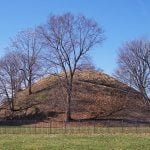
In the absence of any written record of those numerous races which formerly peopled this hemisphere, information must be sought in their monuments, and in the disinterred relics of their ancient manner of life. These, considering the almost unbroken wilderness which presented itself to the first white adventurers, are surprisingly numerous. They indicate the former existence of populous nations, excelling in many of the arts of civilization, and capable, by their numbers and combination, of executing the most gigantic works for religion, public defense, and common oration of the dead. Such relics, though, for the most part, not immediately pertaining to the history of the Indian tribes, have supported the conjectures advanced by Humboldt and other eminent cosmographers, that these races are but the dwindled and degraded remains of once flourishing and populous nations. The retrograde process, to which certain forms of incomplete civilization appear doomed, has perhaps been most strikingly exemplified in the difference to be discovered between the feeble and scattered tribes of the red race, and those powerful and populous communities who occupied the soil before them.
The relics of the former people, usually discovered on or slightly beneath the surface of the ground, are of a rude and simple character, differing little from the specimens common among their descendants of the present day. The flint arrow-head, chipped painfully into shape the stone tomahawk, knife, and chisel the pipe, the rude pottery and savage ornaments, are their only relics; and these differ but little from the same articles still fabricated by their successors.
Except among the Esquimaux, who occasionally use stone, and who avail themselves of the arch and dome in the construction of their snow huts, nothing like regular architecture can be assigned to the late or modern tribes occupying this continent northward of Mexico. The Indian tumuli, or mounds of burial, are generally small and of simple construction. It has, however, been rationally supposed that the force of religious custom, surviving art and civilization, has preserved to the red tribes this characteristic method of their forefathers; and that the rude barrows, which they still erect, are but the puny and dwindled descendants of those mighty mounds and terraced pyramids which still rear their heads from the isthmus to the lakes, and from the shores of Florida to the Mexican Cordilleras.
The origin of these and of other unquestionably ancient remains, is to the antiquarian a question of the most lively and perplexing interest. Here, in unknown ages and for unknown periods, have existed wealth, power, and civilization; yet the remains by which these are indicated seem to furnish but a slight clew to the epoch and history of their long-vanished constructors. Within the mounds and mural embankments scattered through a large portion of this country, are found the remains of high mechanical and scientific art. Pottery, the most fragile of man s works, yet almost indestructible by time, still remains in large quantities and in good preservation. In the composition and coloring of these articles, much chemical skill is evinced; while in many cases, their grace of form and perfection of finish rival the remains of Grecian or Etruscan art. Some of these ancient vessels are of immense size; one, disinterred from a Western mound being eighteen feet in length by six in breadth. Glass beads of rare and elaborate construction have been found; stone ornaments, skillfully wrought, and brick, much resembling that in modern use, have been often discovered.
Metallic remains are frequent. Copper, used both for weapons and for ornament, has often been found, and occasionally specimens, plated with silver, have been disinterred. At an ancient mound in Marietta, a silver cup finely gilt on the inside, was exposed to view by the washing of a stream. It has been often questioned whether the use of iron was known to these aboriginal races; but except the occasional presence of rust in the excavations, little has been ascertained with certainty the perishable nature of that metal peculiarly exposing it to the destroying influence of time and dampness.
Inscriptions upon rocks, mostly of a hieroglyphic character, are numerous; and on the walls of several caverns in the west, some extraordinary specimens may be seen. In the same gloomy receptacles have been found numbers of a species of mummy, most carefully prepared, and beautifully covered with colored feathers, symmetrically arranged. Stone coffins and burial urns of great beauty have also been disinhumed from the Western mounds.
